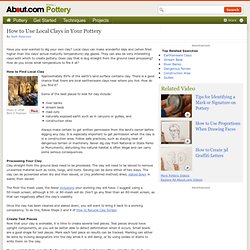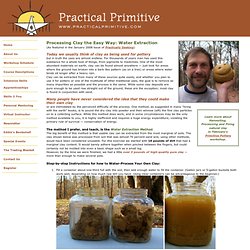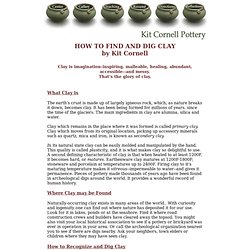

How to Use Local Clays in Pottery - Dig Local Clays for Pottery. Have you ever wanted to dig your own clay?

Local clays can make wonderful slips and (when fired higher than the clays' actual maturity temperature) slip glazes. They can also be very interesting clays with which to create pottery. Does clay that is dug straight from the ground need processing? How do you know what temperature to fire it at? How to Find Local Clay Photo © 2008 Beth E Peterson Approximately 80% of the earth's land surface contains clay. Some of the best places to look for clay include: river banks stream beds road cuts naturally exposed earth such as in canyons or gullies, and construction sites Always make certain to get written permission from the land's owner before digging any clay. Processing Your Clay Clay straight from the ground does need to be processed.
The finer the mesh used, the fewer inclusions your working clay will have. Once the clay has been cleaned and slaked down, you will want to bring it back to a working consistency. Create Test Pieces. 228183 - streamline_vol6_no2_art2.pdf. Processing Clay the Easy Way. (As featured in the January 2008 issue of Practically Seeking) Today we usually think of clay as being used for pottery but in truth the uses are almost endless.

For thousands of years man has used this substance for a whole host of things, from pigments to medicines. One of the most abundant materials on earth, clay can be found almost anywhere — just look for areas where the ground has broken into a bark like pattern (as on a tree) or areas where water tends sit longer after a heavy rain. Clay can be extracted from many of these sources quite easily, and whether you plan to use it for pottery or one of the multitude of other traditional uses, the goal is to remove as many impurities as possible and the process is the same. Many people have never considered the idea that they could make their own clay Learn more about Harvesting,Processing and Firingnatural clayin February'sPrimitive Pottery workshop. or are intimidated by the perceived difficulty of the process. How to Find, process, and fire clay without a kiln. Kit Cornell Pottery: Teaching. HOW TO FIND AND DIG CLAY by Kit Cornell Clay is imagination-inspiring, malleable, healing, abundant, accessible--and messy.

That’s the glory of clay. What Clay isThe earth’s crust is made up of largely igneous rock, which, as nature breaks it down, becomes clay. It has been being formed for millions of years, since the time of the glaciers. The main ingredients in clay are alumina, silica and water. Clay which remains in the place where it was formed is called primary clay. In its natural state clay can be easily molded and manipulated by the hand. Where Clay may be Found Naturally-occurring clay exists in many areas of the world.. If you’re in a wet area and must dig to get to the clay source, don’t stop too soon. If the clay is very workable, you may use it as it is. Ideally, though, clay should be totally dried, then fired in a kiln.
If you have access to firing, you may also glaze your pots, using minerals and colorants to paint or dip your pieces. Country Pottery Kickwheel.